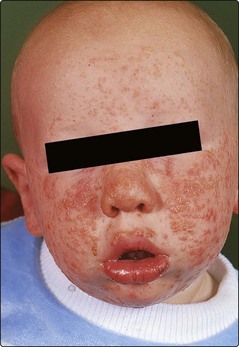Eczema – Atopic eczema
Definition
Atopic eczema is predominantly a disease of childhood that gives rise to poorly demarcated chronic pruritic papular inflammation of the skin. Uncontrollable scratching is prominent. Most cases improve with age, although approximately 50% of children retain evidence of the condition into adult life. For diagnostic criteria, see Table 1.
Table 1 Diagnostic criteria for atopic dermatitis
(Adapted from Williams et al Br J Dermatol 1994; 131 (3): 406–416).
Aetiopathogenesis
Immunology
Individuals with atopic eczema make aberrant immune responses to environmental allergens which become skewed towards Th2 responses (p. 10), inducing allergen-specific IgE production. The basic cause of these immune defects is still unclear. However, the serum IgE is normal in 20% of atopic eczema subjects.
Clinical presentation
The appearance of atopic eczema differs depending on the age of the patient.
Infancy
Babies develop an itchy vesicular exudative eczema on the face (Fig. 1), head and hands, often with secondary infection. About half continue to have eczema beyond 18 months.
Childhood
After 18 months, the pattern often changes to the familiar involvement of the flexures (antecubital and popliteal fossae, neck, wrists and ankles) (Figs 2 and 3). The face often shows erythema and infraorbital folds. Lichenification, excoriations and dry skin (Fig. 4) are common, and palmar markings may be increased. Postinflammatory hyperpigmentation occurs in those with dark skin. Scratching and rubbing cause most of the clinical signs and are a particular problem at night when they can interfere with sleep. Behavioural difficulties can occur, and a child’s eczema can disrupt family life. Occasionally, a ‘reverse pattern’ of eczema is seen, with involvement of the extensor aspects of the knees and elbows.
Stay updated, free articles. Join our Telegram channel

Full access? Get Clinical Tree








